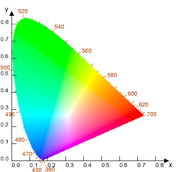Purple
|
|
- Alternate uses: Purple (disambiguation)
Purple is any of a group of colors intermediate between blue and red.
On a chromaticity diagram, the straight line connecting the extreme spectral colors (red and violet) is known as the line of purples (or purple boundary); it represents one limit of human color perception. The color magenta used in the CMYK printing process is on the line of purples, but most people associate the term "purple" with a somewhat bluer shade. There is some common confusion between the color names purple and violet.
| Contents |
Symbolism
Purple sometimes symbolizes royalty, dating back to Roman times, when clothing dyed with Tyrian purple was limited to the upper classes. The color, which was closer to crimson than our idea of purple, was the favored color of many kings and queens. Byzantine empresses gave birth in the Purple Chamber of the palace of the Byzantine Emperors. Thus being named Porphyrogenitus ("born to the purple") marked a dynastic emperor as opposed to a general who won the throne by his effort. Oddly, porpora or purpure was not one of the usual tinctures in European heraldry, being added at a late date to bring the number of tinctures plus metals to seven, so that they could be given planetary associations. the classic early example of purpure is in the coat of the Kingdom of León: : argent, a lion purpure as early as 1245.
In the 1800's William Perkins invented mauve, a shade of purple, from coal oil. It quickly became popular among all classes, and sparked major industrial development in the German chemical industry.
In the United States and United Kingdom militaries, purple refers to programs or assignments that are "joint", i.e. are not confined to a single service such as the Army or Navy but apply to the entire defense establishment. Assignment to one or more joint billets is required for promotion to flag rank (Rear Admiral and higher) in the U.S. Navy. Officers in joint billets are sometimes referred to as "wearing purple" (the phrase is purely metaphorical as there are no purple uniforms in the U.S. or UK armed forces).
Purple as one of the liturgical colours in Christian symbolism can express sorrow and mourning.
Purple is also a symbol of womandom, feminism, or lesbianism. In one such use, members of the Red Hat Society (women over 50) wear purple dresses with red hats.
In politics in the Netherlands, purple means a government coalition of right-liberals and socialists (symbolized by blue and red, respectively), as opposed to the more common coalitions of the Christian center-party with one of the other two. From 1994–2002 there have been two purple cabinets—see also Politics of the Netherlands and Paars (the Dutch word for "purple"). Purple is symbolic for courage.
Purple is the name of a drink consisting of lager, cider, and blackcurrant commonly consumed by students in the UK. See Snakebite.
Purple versus violet
The colour terms purple and violet cause confusion for many people. This is because the two colour categories overlap to a considerable extent, and different cultures use the two terms in different ways. Many people think of the terms purple and violet as having no difference at all.
In many contexts, such as art, the terms are fairly straight-forward, however. Purple is a colour intermediate between red and blue which veers more towards the red part of the spectrum. Violet, on the other hand (and, as the colour of the flower suggests), veers more towards blue. Purple also tends to be a richer, more saturated colour. In RGB terms, purple actually tends to contain fractionally more red, but also considerably more blue. In CMYK terms, purple contains more black but less cyan and magenta.
The two terms are also different in a psychophysical context. On a chromaticity diagram, purples lie along a line connecting the extreme colours red and violet, and the colour is thus located between the two in hue. It lies closer to violet than do cerise, crimson, madder, magenta and other pinkish-reds. Violet, by way of contrast, lies closer to blue than purple, but not as close as indigo.
In a colour circle, violet's wavelength (around 440nm) is seen within the visible spectrum, at the extreme blue end. Purple does not lie within the spectrum as such (although, obviously, it is visible), but is rather the admixture of the colours at the two ends of the spectrum (red and violet). As such, it lies in the colour wheel's "gap" - at extraspectral region representing hues that in themself do not have a unitary wavelength specification.
One interesting psychophysical feature of the two colours which can be used to separate them is their appearance with increase of light intensity. Violet, as light intensity increases, appears to take on a far more bluey hue as a result of what is known as the Bezold-Brücke shift. The same increase in blueness is not noted in purples.
References
- "The perception of color", from Schiffman, H.R. (1990) Sensation and perception: An integrated approach (3rd edition). New York: John Wiley & Sons.
See also
Template:Web colors de:Purpur (Farbe) es:Púrpura fr:Pourpre ja:紫 nl:Paars vi:Tía zh:紫色

